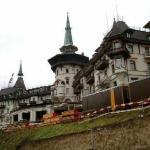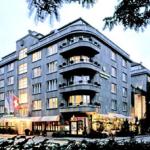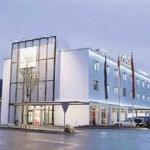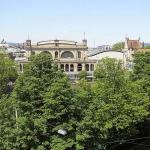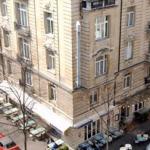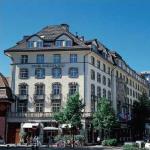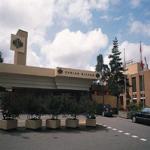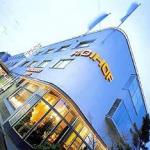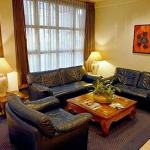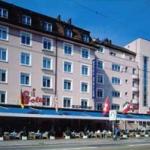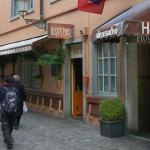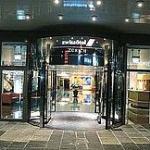Sights Zurich, Switzerland
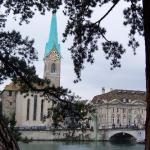 Grossmünster
GrossmünsterThe cathedral in Romanesque and Gothic styles has two three-storey tower and is located on a terrace above the Limmatquai, on the right bank. Construction of the cathedral began in 1090 and finish construction before the 14 th century. Choirs include the magnificent stained glass windows, executed in 1932 by Augusto Giacometti. The oldest part of the cathedral date from the end of 11, the beginning of 12 century. It may be noted cloister in the Romanesque sculptures late 12 century.
Once this cathedral was the parish church of Ulrich Zwingli - one of the great leaders of the Reformation. He persuaded the priests to marry (he was married), railed against the "idolatry" and mass communion. In 1531 Zwingli was killed in a religious war in Cappel. Executioner quartered his body and the soldiers burned the remains. In place of his execution inscription - "They can kill the body but not soul." In accordance with the convictions of Zwingli, Grossmünster strict, no heavy jewelry. View from the towers is impressive.
Located there before the church school was replaced in 1853 the first school for girls (Wegmann); today it is building the theological faculty of the University.
House Craftsmen Guild
One of the most famous buildings in the city guild of craftsmen. Since 1752, the house is part of the Swiss National Museum. It focuses mainly 18 th century Swiss ceramics, porcelain of Zurich, and some ancient works.
Lindenhof or Linden Yard
The area offers a wonderful panoramic view over the city and the river Limmat. On this site once stood the Roman fort and customs station.
Museum of Fine Arts
One of the most important art museums in Europe, focuses mainly on 19 and 20 centuries, although there are paintings and sculptures of ancient times. The museum was founded in the Victorian era and was renovated in 1976. Today it is one of the most modern museums in the world.
Near the entrance to the museum you will see the sculpture of Rodin's "Gates of Hell. The museum contains masterpieces of another famous Swiss sculptor and painter, Giacometti. Collection of works in the Art Nouveau style includes works by such great artists as Bonnard, Braque, Chagall, Marini, Mondrian, Picasso, Rouault. Gallery has the largest collection outside of Oslo, the Norwegian artist Edvard Munch. Two old masters Rubens and Rembrandt also represented. To brighten a rainy day come to see paintings by Cezanne, Degas, Monet, Toulouse-Lautrec and Utrillo.
Museum Rietberg
Collection of European art not Rietberg Museum is located in three buildings. Two of them, dating back to 1850 mi for years, Rieter is in a park in Zurich. In the neoclassical villa Vezendok is a special exhibition, in which the collected works of art from India, China, Africa, Japan, and Southeast Asia. This rich collection was formed by Baron Van der Geydtom, German banker, was interested in foreign culture and shared passion for the Buddhist philosophy of Schopenhauer. Vezendokov Villa was built in the mid-19 century Vezendokov family, which moved from New York to Zurich. They used his prestigious villa as a meeting place for leading artists, intellectuals and scientists of his time. Richard Wagner was their guest during the year, here he wrote the first version of Tristan and Isolde, and the inclusion of the five songs inspired by poems of Mathilde Vezendok. A hundred years later the city bought a villa at Rieter, a family of industrialists working in the textile industry.
The collection also includes statues from India, Java, Africa and the islands of Oceania. Complement the exhibition collection of Japanese publications, works of art from the Middle East, Tibet and American paintings from the Far East, a collection of Swiss masks and Flemish and Armenian carpets. At Villa Park Rieter are paintings from China, Japan and India. It also hosts concerts of world music. In the third building is a traveling exhibition.
Urania Observatory
The observatory is located between the street of Bahnhofstrasse and the Limmat River in the street Uraniastrasse. On clear days you can look through the telescope, and on cloudy days, the observatory is closed. Call in advance to find out. The observatory is located on the site since 1907. With this central location you can enjoy a panoramic view not only in Zurich, but also rising above the lake and the Alps in the distance. You can look at the stars, planets and galaxies through a large telescope Zeiss, which weighs 20 tons.
Ratusha
Outstanding building in Zurich in the Baroque style dates from the years 1694-98. Its interior is preserved as well as the facade: a luxuriously decorated ceiling in the banquet hall and a good ceramic stove in the room.
Collection E. Bührle
Treasures of the collection are the most popular due to the works of French Impressionists, including Monet, Van Gogh, Cezanne, Gauguin, Degas, Renoir and Manet. Look at works by Picasso - The Italian girl. Private collection also includes paintings by Rubens, Rembrandt and Guardi. It will be interesting and a special section of 24 sculptures of the Middle Ages.
Fraumünster
This magnificent church is located on the left bank of the river and goes to one of the oldest areas of Zurich Münster. Benedictine Abbey was founded at this place in 853 by Emperor Ludwig. His daughter became the first abbess of the Abbey. This same church dates from the 13th and 14th centuries.
The main attraction Fraumünster are five stained glass windows - each with its own color theme - created by Marc Chagall in 1970 is best they can be seen in the bright morning light. The basilica has three aisles. The nave is Gothic.
St. Peter's Church
St. Peter's Church was built in the 13 century on the left bank south of Lindenhof - is the oldest church in Zurich. There are watches with the largest clock face in Europe: 9m in diameter, the minute hand length of almost 4m. Inside are choruses Romanesque chapel of the nave and three in the Baroque style. Beautiful interior produces the impression that you are in the ballroom, but not in the church.
Swiss National Museum
This museum offers a grand overview of culture and history of the people of Switzerland. His collection, presented in a building constructed in the 19 century, includes works on religious themes, including the glass from the 16 th century monastery Tanikon and frescoes from the church Mustair. Some of the works of art date back karolingianskogo 9 century.
Prehistoric section is also unusual. Some of the artifacts - from 4 millennium BC. Submitted by Roman clothing, medieval cutlery, drinking cups 14 th century, and porcelain 17 th century, as well as painted furniture, costumes, doll houses and different times. The exhibition of weapons and armor reflects the Swiss methods of warfare from 800 to 1800. There is also an exhibition tracks the production of Swiss watches from 16 to 18 century.
Holidays in Zurich
Street Parade - a tehnoparad in Zurich, which can be compared with the Berlin Love Parade. The parade runs along Lake Zurich. Street Parade is one of the biggest techno hangouts in the world and the largest annual event in Zurich. The first street parade took place in 1992 at the initiative of the student Marek Krinsky and officially called "The demonstration in the name of love, peace, freedom, generosity and tolerance". In the parade in 1992 consisted of about 1000 people, a year, with 10,000 ravers, the parade was a great event. In 1994, the city tried to prevent street parade, but due to the strong protest of the population of the city government was forced to lift its ban. Since then, the parade began to take place annually in early August. Since 1996, he organized the association of street parades. Like the Love Parade in Berlin, it was commonplace for participants to climb trees, poles, cabin toilets, etc., but after several incidents where people have suffered, it is not allowed. Parade gradually grew considerably in size. In 2001 this event was recorded as over a million participants. In 2003 and 2005 found mobile Ferris wheel, 60 m in diameter, giving a fantastic view of the parade. Zury Fascht held every three years in early July. From Friday to Sunday, the old city and the shore of Lake Zurich and the Limmat River are transformed into one big fair.
Sechselauten - the spring festival, usually held the third Monday in April. On Sunday the children's parade. Home Entertainment - a parade in the city center in historical costumes and the burning of "The Scarecrow» (Boogg). Scarecrow is made from cotton, wool, and is filled with fireworks. It is burned at 6 pm at Sechselautenwiese. This ritual mark the completion of the winter.
St. Nicholas Day - despite the fact that St. Nicholas Day, December 6, is not an official holiday, it is celebrated in some parts of Zurich's traditional parades.
Fasnacht - Zurich Carnival takes place in February and early March. Groups of musicians roam the streets and held the ceremonial processions and public balls, masquerades.
